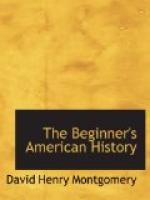183. How much cotton New Orleans sends to Europe; Eli Whitney’s work; who it was that bought New Orleans and Louisiana for us.—To-day the city of New Orleans, near the mouth of the Mississippi River, sends more cotton to England and Europe than any other city in America.
If you should visit that city and go down to the riverside, you would see thousands of cotton bales[1] piled up, and hundreds of negroes loading them on ocean steamers. It would be a sight you would never forget.
[Illustration: LOADING COTTON AT NEW ORLEANS.]
Before Eli Whitney[2] invented his machine, we sent hardly a bale of cotton abroad. Now we send so much in one year that the bales can be counted by millions. If they were laid end to end, in a straight line, they would reach clear across the American continent from San Francisco to New York, and then clear across the ocean from New York to Liverpool, England. It was Eli Whitney, more than any other man, who helped to build up this great trade. But at the time when he invented his cotton-gin, we did not own New Orleans, or, for that matter, any part of Louisiana or of the country west of the Mississippi River. The man who bought New Orleans and Louisiana for us was Thomas Jefferson.
[Footnote 1: A bale or bundle of cotton is usually somewhat more than five feet long, and it generally weighs from 400 to 550 pounds. The cotton crop of this country in 1891 amounted to more than 8,650,000 bales; laid end to end, in a straight line, these bales would extend more than 8000 miles.]
[Footnote 2: 2 See paragraph 180.]
184. Who Thomas Jefferson was; Monticello;[3] how Jefferson’s slaves met him when he came home from Europe.—Thomas Jefferson was the son of a rich planter who lived near Charlottesville in Virginia.[4] When his father died, he came into possession of a plantation of nearly two thousand acres of land, with forty or fifty negro slaves on it.




